The commercial and recreational mutton snapper size limit is 18 inches in total length. They are given this size limit because of the higher demand. Mutton Snapper fish is a food-grade fish that has an extreme price tag. Do you wonder why they are expensive? Let’s find out more facts and details about mutton snapper fish from this article.
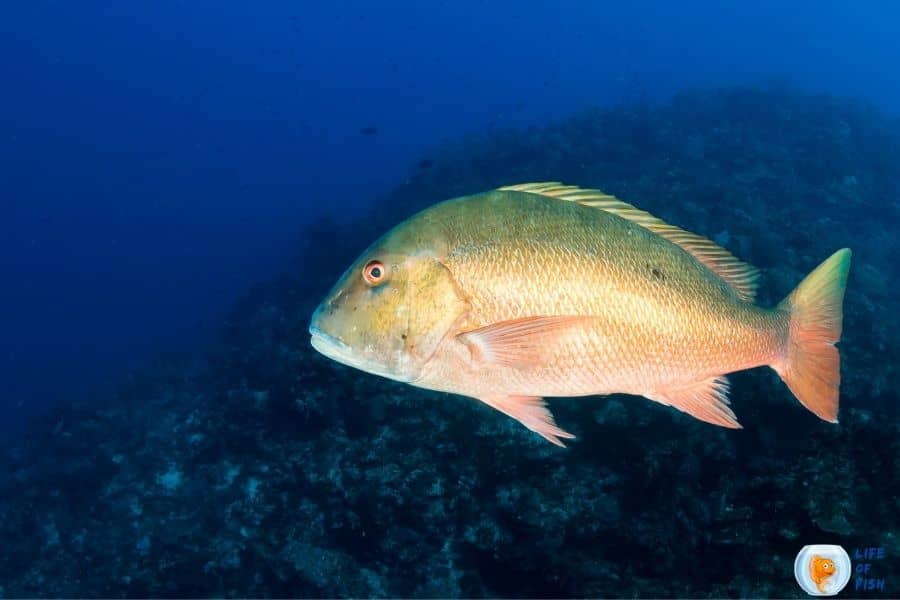
What is mutton snapper fish
Jump To
- 1 What is mutton snapper fish
- 2 How Mutton snapper fish looks like
- 3 mutton snapper size variation
- 4 Growth of Mutton snapper fish
- 5 The dentition of Mutton snapper fish
- 6 Male and female fish
- 7 Where mutton snapper fish live
- 8 What do they eat?
- 9 Mutton snapper fish reproduction
- 10 Importance of mutton snapper fish
- 11 Related question
- 12 Conclusion
Scientifically named Lutjanus analis, the mutton snapper is a species of snapper under the Actinopteri family. They are native to the Atlantic coastal seas from Massachusetts to southern Brazil, the Caribbean Sea, and Mexico’s Gulf. This fish is reported to live for around 29 years and grow massively from about 50cm to 94cm long. However, most fish don’t grow beyond the 50cm mark.
The largest fish recorded in this species was 15.6kg. IUCN listed this species as near threatened in 2015 because of fishing for food and game. Mutton snappers are highly commercial fish because of their nutrients, and due to their fighting abilities, they are popular as game fish. These fish are also rarely seen in the aquarium trade.
How Mutton snapper fish looks like
Mutton snapper fish is a large fish species that has an almond-shaped body. The typical size of this fish species is 50cm. They are primarily abundant around the Antilles, the Bahamas, and off southern Florida.
Color
The back and upper sides of the mutton snapper are olive green in color. They have a red tint on the sides and underside and have distinct markings such as a patch on their upper side, and blue lines under the eyes. Also, they have a distinctive black color spot between the lateral line and dorsal fin. At rest, they have paler stripes across their backs, which become a solid color as they swim.
Shape
The body of the mutton snapper is almond-shaped, with pointed fins and a crescent tail fin. The pectoral fins are quite long, reaching the level of the anus. Rows of scales on the back, rising obliquely over the lateral line.
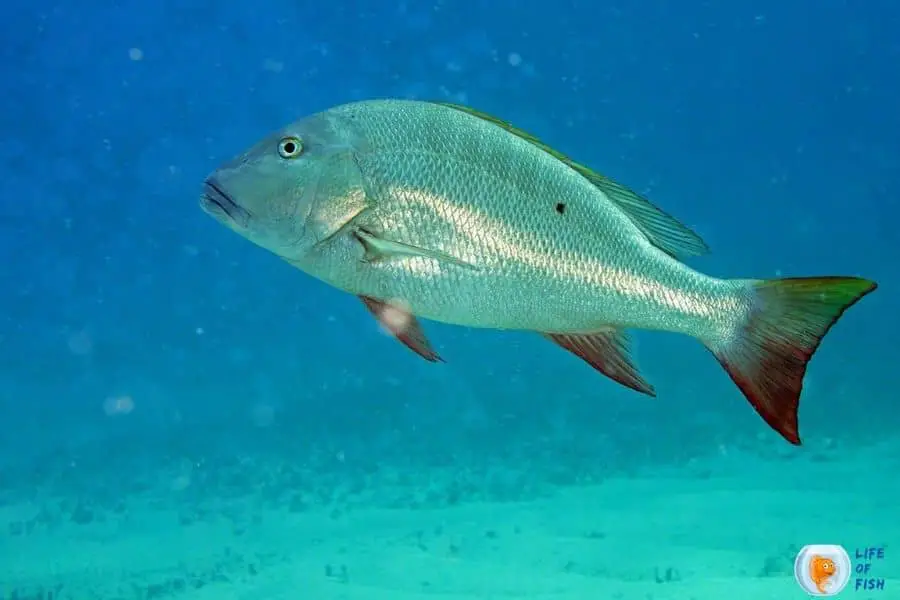
mutton snapper size variation
The typical length of matured Mutton snapper is 50cm long, and the maximum size they reach is 94cm. The maximum reported weight is 15.6kg. As you see, the Mutton snapper fish is a large-sized, deep-bodied fish you can see in the ocean.
Growth of Mutton snapper fish
The juveniles become mature when they reach about 28 to 40 cm long. They can weigh up to ten or fifteen pounds (4.5-6.8 kg). The Mutton snapper’s maximum life expectancy is 40 years. According to one scientific study, the average length of a mutton snapper ranges from 16.1 cm (6.3 inches) at one year of age to 77.8 cm(30.6 inches) at 14 years of age. Mutton snappers gain weight faster between ages 5 and 10 years.
The dentition of Mutton snapper fish
Mutton snapper has relatively small teeth, and they are similar in both jaws. It uses a v-shaped vomerine tooth patch on the upper jaw with little sharp teeth to grasp prey.
Male and female fish
According to a study1, female fish are overpopulated in schools. Female fish are usually smaller than male fish. Females range in length from 28.0 to 69.0cm (TL), while males range from 35.0 to 75.0cm (TL). Female fish lay as many as 1,400,000 eggs which hatch 20 hours after fertilization.
Where mutton snapper fish live
The mutton snapper lives in the western Atlantic’s warm, temperate, and tropical seas, ranging from New England to southeastern Brazil. They also live in the Bahamas and the Gulf of Mexico. You can find mutton snapper in abundance in the waters of southern Florida, the Bahamas, and the Antilles.
Mutton snappers have various habitats according to age. Juveniles and small adults usually live in shallow coastal seas over coral reefs, in protected bays with grass beds or mud bottoms, in mangrove-lined tidal creeks, and in canals. Larger adults usually live in the deep sea on the continental shelf out to 91- foot (28-m) depths.
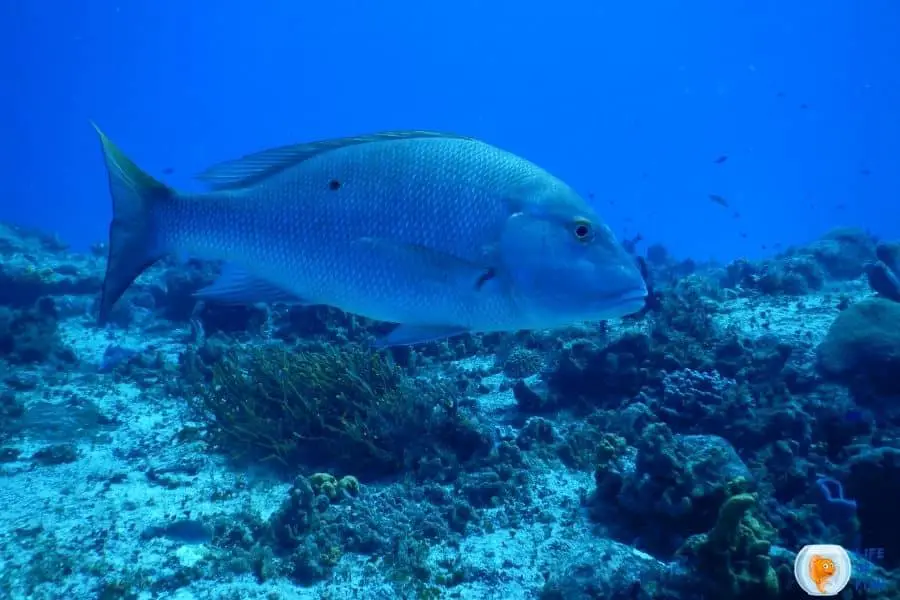
What do they eat?
Mutton snappers are nocturnal predators. These carnivorous species feed on fishes, particularly small grunts (family Pomadasyidae) and nocturnally active crustaceans. Mutton snappers generally feed by collecting food organisms from the substrate’s surface. They eat at all hours of the day and night.
Winnowing (separating prey from the substrate) occurs in the afternoon and evening when midwater strokes occur only in the morning and evening. The fish have dark, barred color patterns when eating on the substrate, but no color change happens during midwater strikes. During the day, small fish less than a year old feed more frequently than medium or large fish, and they have very few contacts with other mutton snappers.
Mutton snapper fish reproduction
Reproduction of Mutton snappers happens in specific areas in the same time frame and in the same place, year after year. They exhibit high site fidelity and mostly spawn off the coasts of Cuba, the Turks and Caicos, and the U.S. Virgin Islands seasonally. The remaining known spawning aggregation of mutton snapper in the continental United States is located in Riley’s Hump near the Dry Tortugas area off Key West, Florida.
In the Carebian region, they spawn during the month of February, and in other areas, they spawn during May and June, in the summer. All snappers are oviparous, which means they lay pelagic eggs that float freely with the currents. The quantity of eggs produced is determined by the size of the female. Female fish can usually lay up to 1,400,000 eggs in one cycle. Adult fish migrate offshore to deeper waters after spawning.
The eggs will hatch within 20 hours of fertilization. The larvae tend to be planktonic, less than 10mm long. They eventually go into protected habitats and grow there. The juveniles have Green/brown lateral stripes and translucent fins when measuring 15mm in length. When juveniles are 22mm long, they feature faint yellow lateral stripes and a dorsolateral patch.
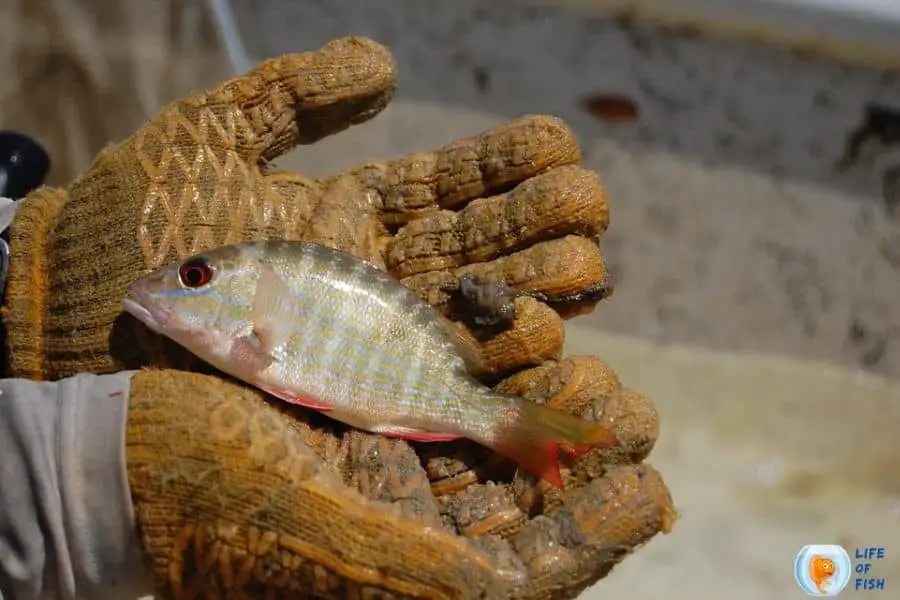
Read More: Breeding Tiger Barbs – A Comprehensive Guide You Must see
Importance of mutton snapper fish
Mutton snappers are considered an important fish species because of their high quality of food and the decline of the fish population over the years. The fish population has decreased dramatically over the years because of overfishing, as they are vulnerable because of their patterned reproduction behavior.
Ecosystem balance
Based on information collected over a 30 to 50 years period, IUCN2 estimated that the biomass of the stock has declined by at least 20%; hence they listed Mutton snappers as ‘Near Threatened’ species. Overfishing has caused a decline in spawning aggregation. If this trend continues, then IUCN expects the status of this species could worsen to ‘vulnerable species.’
Sportfishing
Mutton snappers are also known as good fighters. Therefore, they are popular as game fish. Saltwater anglers catch these fish on a wide range of baits, including frozen shrimp, entire or lower squid, minnows, and smaller baitfish, as well as synthetic baits.
As a food
The flesh of mutton snappers is considered very high quality. Therefore, the flesh sells at a higher price range—specifically, the meat from the cheeks and throats of larger snappers. People consider them gourmet delicacies.
Related question
What kind of fish is mutton?
The mutton snapper, scientifically named Lutjanus analis, is a marine ray-finned fish snapper species in the Lutjanidae family. These fish live in the Western Atlantic Ocean.
What does mutton snapper taste like?
The flesh of the mutton snapper has a lean, firm texture. It has a minimal fat composition, but it tastes delicious. The white flesh is light pink, and it has a mild and sweet taste with a hint of nutty flavor. People call this flesh red snapper; the flesh compliments both mild and intense seasoning, making it easy to serve.
When cooked, the flesh becomes lighter, and it tastes great when fried, baked, poached, grilled, broiled, or steamed. Mutton snappers taste not only good but also are healthy and nutritious. The flesh has high-protein content with low calories and essential amino acids, making it an expensive food.
Are muttonfish poisonous?
Mutton fish are famous as delicious and nutritious food, and people love eating this fish. However, there are some reports of ciguatera poisoning by eating muttonfish. The cause for this mutton poisoning was some toxins the fish ingested from eating algae along a coral reef in the Bahamas. Although the fish itself is not poisonous, if the fish ate toxic algae before catching, eating its flesh can be poisonous.
Are muttonfish good to eat?
Though mutton snapper fish has a risk of ciguatera poisoning, it is one of the most delicate marine food on the market. Mutton snappers are delicious, nutritious, and good to eat. The flesh of this fish sells for higher prices as they are tasty, healthy, and, most importantly, rare.
Ciguatera poisoning can happen from any reef fish, and it happens rarely. Only about 50000 reported poisonings worldwide per year, and not all of them because of mutton snapper fish. And ciguatera poisoning rarely causes death. So, a few known cases of ciguatera poisoning shouldn’t prevent you from eating this nutritious and delicious fish.
what is the best bait for mutton snapper?
When doing Mutton snapper fish, goggle-eye, thread herring, speedo mackerel, squid, ballyhoo, shrimp and crabs consider as best baits.
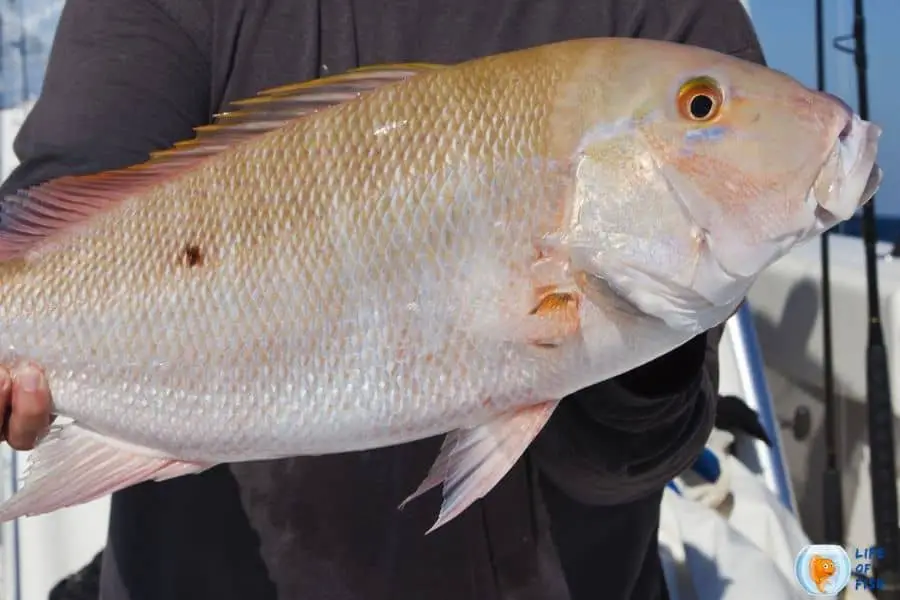
Conclusion
Mutton Snapper fish are highly commercial game fish that are listed as ‘Near Threatened’ species by IUCN. Overfishing has caused these fish to abandon reproduction in recent history. Mutton snappers are sold under the “Red Snapper” label, and the price tag of this flesh is high because of its delicacy and nutritional value. Like any other reef fish, mutton snappers also carry the risk of ciguatera poisoning. But, it is one of the must-taste marine foods recommended in the fish industry.
Reference
- Teixeira, S.F., Duarte, Y.F. and Ferreira, B.P., 2010. Reproduction of the fish Lutjanus analis (mutton snapper; Perciformes: Lutjanidae) from Northeastern Brazil. Revista de Biologia Tropical, 58(3), pp.791-800.
- IUCN. 2009. IUCN red list of threatened species, Geneva, Switzerland. (Downloaded: August 7, 2021, www.iucnredlist.org).
Read Next: Cobra Guppy (Poeciliia reticulata) Ultimate Care Guide
